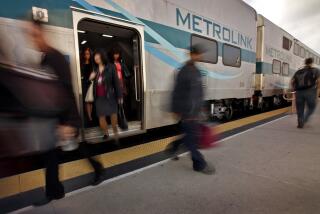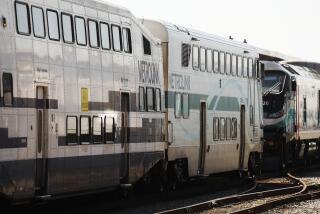Runaway Train Jumps Tracks in Commerce
A runaway freight train reached speeds of 70 mph before it was derailed without warning Friday by Union Pacific railroad officials, sending a string of cars loaded with lumber into a Commerce neighborhood, destroying or damaging four homes and injuring a dozen people, none seriously.
The 31 freight cars had rolled free in a switching yard in Montclair during what should have been a routine decoupling and traveled nearly 30 miles on a rail line headed for downtown Los Angeles. Railroad officials said they had few choices on where or how to stop the train during the more than 20 minutes the cars barreled toward Los Angeles.
Without notifying state or local emergency officials, they diverted the speeding cars onto a side track, causing the train to derail.
Commerce city officials called Union Pacific’s actions irresponsible and asked why no one was notified of the impending danger.
Residents ran for safety shortly before noon as 11 of the freight cars toppled onto Davie Avenue, a blue-collar neighborhood of single-family houses separated from the rail line by a chain-link fence. A brother carried his pregnant sister to safety seconds before freight cars crushed their home. Crying children were passed over cinder-block walls to emergency workers. A father broke a living-room window to free his daughters after debris blocked the front door.
Neighbors described a scene that seemed like a cross between an earthquake and a tornado as a cloud of white dust and rocks, mixed with tons of lumber that had been carried in the open freight cars, came crashing down.
Officials and employees at Union Pacific on Friday recounted a series of missed opportunities and poor communication during failed attempts to stop the train from leaving the yard.
David Manning, manager of terminal operations for Union Pacific in Los Angeles, declined to assign blame for the crash, but he said it seemed unlikely that the train was set loose by an equipment failure. He noted that each of the cars has its own set of air brakes, which should have been engaged.
They had to have been released -- either manually or as a result of equipment failure -- for the cars to roll.
“Equipment failure is pretty rare,” Manning said, “especially on 30 cars.”
A source close to the investigation, who spoke on condition of anonymity, said a crew was working on the train in the yard and a worker at the front of the train mistakenly believed the brakes had been set at the rear. Meanwhile, a worker at the rear made the same mistake, believing the front brakes had been engaged.
When crew members realized the cars were rolling, one worker ran after them, then jumped in his automobile and began chasing them, Manning said, hoping to head them off at a crossing. It was not clear what he might have done to stop the cars.
At the same time, Manning said, another crew member tried to call Union Pacific’s dispatch center in San Bernardino, but the dispatcher was busy with another train.
The worker then hit an emergency button, prompting the dispatcher to call back. Manning said the delay from the time the worker first called to the time the dispatcher called back was no more than 30 seconds.
Manning said the rail crew wanted to use a locomotive to chase down the runaway train, but they had a hard time reaching the dispatch center for permission. Two conductors at the yard, who declined to give their names, said the crew was ordered not to try the maneuver.
Warren Flatau, a spokesman for the Federal Railroad Administration, called the accident uncommon. He said minor derailments are not unusual, but it is almost unheard of for a train to break loose from a switching yard.
“This is quite remarkable,” he said. “This combination of events, cars rolling out of a switching yard and rolling for a long way, that type of combination makes this unusual. It is not your typical derailment.”
Crew members at the yard underwent drug and alcohol testing Friday afternoon, Manning said. Investigators from the National Transportation Safety Board began looking into the cause of the accident.
The first reported sighting of the train by non-railroad officials came four miles down the tracks from the Montclair switching yard.
Pomona Police Cpl. Linda Weidner was stopped in her patrol car at the closed gates of a railroad crossing, explaining to her rookie partner which routes to take in an emergency to avoid trains.
Her partner, Ralph Rivera, asked why the train had no engine pulling it and Weidner explained that sometimes trains were pushed from behind.
Seconds later the train passed with no locomotive in the rear.
“Wow, it’s going fast,” Weidner said. She estimated the speed at more than 65 mph, faster than any train she had seen going through the city.
“It’s a runaway train!” Rivera said.
It was 11:41 a.m. They radioed in, asking dispatchers to alert the railroad.
Twenty minutes later, the first 911 call to Los Angeles County fire officials came from a witness at the scene. State emergency officials said they were not notified of the runaway train by Union Pacific officials until 12:12 p.m., after television news showed the crash.
Three children and two adults suffered minor injuries and were treated and released at hospitals. Seven other people were treated at the scene, according to county Fire Department officials.
Railroad officials defended their actions, saying their priority was halting the train before it reached downtown Los Angeles.
“This was our last opportunity to stop it,” said Union Pacific spokesman John Bromley. “We knew there were other trains downtown. If it hit other trains or had gone into the downtown area, that was not something we could contemplate.”
Bromley said railroad officials were aware that switching the speeding train to another track would likely cause it to derail.
“We didn’t know it was going to crash into houses, though,” Bromley said. “As soon as we saw this thing was a runaway, we were looking for places to get it off the track. This is not a situation where everyone sits around a conference table and tries to figure it out.”
The railroad’s acknowledgment that the freight cars had been intentionally diverted onto a side track, causing it to crash, came more than five hours after the accident.
Commerce Mayor Jesus M. Cervantez was critical of Union Pacific officials.
“I do not know why they did this,” he said Friday evening. “If they had thought about this, less than a mile away there is a railroad yard where there are no residents and they would not risk anyone’s life. If they decided to do this intentionally, they should have at least informed the city. I’m very, very upset and the whole City Council will be demanding a complete investigation.”
Cervantez said he spoke briefly with Union Pacific representatives earlier in the day who told him only that they had had a problem while switching rail lines.
“I believed them at the beginning, but I do not believe them anymore,” the mayor said. Depending on the outcome of an investigation, he said, “we will hold them responsible for their actions.”
Kathryn Blackwell, a spokeswoman for the railroad, said Friday that derailment was “one of the risks.... I don’t know that we knew how fast it was going. When we diverted the train onto a siding, it could have just slowed ... a wheel could have fallen off, causing it to stop without derailing.”
As for the anger in Commerce and the questions over why the diversion of the cars was not attempted on a stretch of track in a train yard further ahead, Blackwell said: “If there was a possibility that we could have done this in a place with less impact, we would have done that.”
She said people making critical comments “don’t know our operations.... There may have been another train ahead, may have been fuel containers ahead.”
The two conductors, who would not give their names, said dispatchers could have rerouted the train onto another line that goes to Santa Fe Springs. That line splits off about four miles before the Commerce neighborhood where the train derailed. They said the train probably would have derailed on that line too, but that it would have been in a much less-populated area.
Engineering experts said that because trains operate with a minimum of friction between the tracks and the wheels, it might not take much to send untethered freight cars running away.
“A little bit of downhill grade will do it. With wheels, there’s little friction and it could roll really far,” said Thomas Katsoulas, a professor of electrical engineering at USC. It would take only a slight incline for a train to gain considerable speed, he said.
Once a loaded train picked up speed and hit a curve in the track, he added, it could easily overturn. There is a decline of about 800 feet over the nearly 30 miles the train traveled.
In the aftermath, more than two dozen Los Angeles County fire and sheriff’s units responded to the accident and more than 100 emergency personnel arrived, including a search-and-rescue unit. Many who were first on the scene said they were amazed that no one was killed.
Firefighter-paramedic Terry Millsaps, from Fire Company 39, was called out early to treat the injured. “We saw a lot of shaken nerves,” he said. Injuries were mostly “cuts to the arms, scratches and scrapes.”
“I thought driving over here that we were going to have a lot of body recoveries,” Millsaps said. “I am really surprised.”
Sheriff’s Deputies Henry Saucedo and partner Hector Andujo were on patrol in East Los Angeles when they got the call. They parked at the corner of Davie Avenue and Ferguson Drive, about 100 yards from the crash scene. Almost immediately, Saucedo saw a man with bloody hands wave to him from behind a block wall, calling for help in Spanish.
Saucedo said he climbed onto a pile of wreckage next to the wall and the man started handing children over to him.
“When I saw the kids, I expected the worst,” Saucedo said.
He passed the children to his partner within several feet of “a maze of live wires” that had come down from a power pole.
As news of the crash was aired on television, anxious relatives and residents rushed home from work.
The two police officers who called in a report on the runaway train learned of the disastrous outcome more than half an hour later while investigating a suspected burglary.
“We looked at each other and I knew that was the train and I was worried,” Weidner said. “I was hoping nobody was killed or seriously injured. We see strange stuff out here everyday. But you don’t expect something to be wrong like that.”
Luis Carlos Vasquez Jr., 31, the man who carried his pregnant sister to safety, called it an “act of God” that they were both alive and well.
“They say when it’s your time, it’s your time,” he said. “But today wasn’t our time.”
*
Times staff writers Andrew Blankstein, Stephanie Chavez, Michael Krikorian, Mitchell Landsberg, Jill Leovy, Usha Lee McFarling, Jean Merl, Jennifer Oldham, Lee Romney, Louis Sahagun, Doug Smith and Richard Winton contributed to this report.
More to Read
Sign up for Essential California
The most important California stories and recommendations in your inbox every morning.
You may occasionally receive promotional content from the Los Angeles Times.













